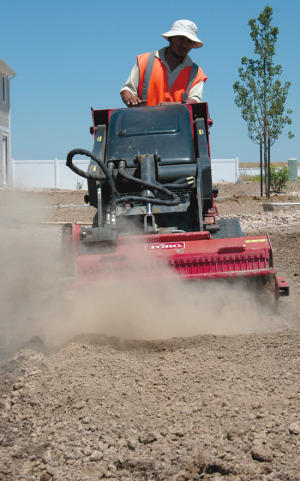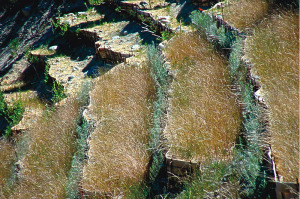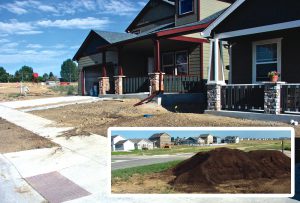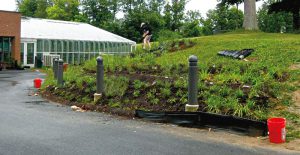Municipalities everywhere are realizing that some of the environmental issues they are grappling with locally may be mitigated by healthier soils.
Rachel Cernansky
BioCycle October 2014

New properties within Denver Water’s service area are required to amend soils with 4 cy of compost/1,000 sq. ft. of permeable area to a depth of 6 inches. Photo courtesy of Denver Water
In the late 1990s, when Puget Sound Chinook salmon was listed as threatened, Washington State officials scrambled to find ways to improve water quality in the Puget Sound and protect spawning streams. They identified a number of methods to reduce environmental impacts and restore salmon habitat, including addressing a simple but growing problem: the loss of water infiltration into soil and an increase in storm water runoff, carrying pollutants and sediment into streams.
One easy target? Construction sites. When developers build, they often strip and compact all soil on the plot, and historically there’s been little concern about the health of the soil (beyond ensuring it’s stable enough to support a house). That’s had consequences for landscapes and waterways. When topsoil is lost and soil is compacted, it loses most of the functions that it provides when it’s healthy. It doesn’t hold or filter water very well, surface water runoff increases — which means increased contamination of nearby waterways — and its ability to support plant growth and resist disease plummets. The need for landscaping inputs — fertilizer and pesticides — also climbs, exacerbating water pollution.
In Washington, officials realized this approach to land development was contributing to the decline in salmon populations. “In looking for some way to turn that around, we focused on these large land areas that were losing the ability to work as a sponge — to soak up storm water and clean it,” recalls David McDonald, resource conservation planner at Seattle Public Utilities in Seattle, Washington.
In 1999, McDonald and others helped to launch the Soils for Salmon initiative, to promote simple best practices for developers that would rebuild soil health — protecting native soil where possible and restoring construction-disturbed soils with compost amendment. Organic-amended soils sustain plant life, filter and retain water, trap metals and nutrients and biodegrade contaminants, and ultimately reduce the quantity of chemicals and water applied for landscaping purposes.

The Soils for Salmon initiative in Washington State, launched in 1999,
led to policies and practices to restore construction-disturbed soils with compost amendment. Side by side comparison of soil amended with compost to unamended soil (top, left) is shown at Washington State Department of Transportation site near Chelan. Photo courtesy of WA DOT
What started as a list of best management practices (BMPs) has become law in many municipalities in Washington. The state’s storm water management manuals for both Western and Eastern Washington now require soil protection and restoration with compost on construction sites. In Western Washington, the storm water manual recognizes that the many ecosystem services provided by soil and vegetation are lost “when development strips away native soil and vegetation and replaces it with minimal topsoil and sod.” And, notes the manual, the landscapes themselves become “pollution-generating” surfaces.”
Thus, the state’s storm water manuals and local codes require 3 inches of compost to be tilled 8 inches into the soil for planting beds, and 1.75 inches of compost tilled in 8-inches deep for turf areas. (Alternatively, a “calculated rate” can be used to meet the organic matter content requirements, which are 8 inches of settled soil at 10 percent organic content for planting beds, and 5 percent organic content for turf.) The soil must be scarified an additional 4 inches to achieve a total depth of 12 inches of uncompacted soil after the calculated amount of amendment is added.
Scientific trials in Washington and elsewhere have shown that these simple soil BMPs can reduce storm water runoff by 50 percent or more, and also reduce the summertime need for landscape irrigation by 50 percent — which pays for the amendments in three to five years.

Fort Collins, Colorado adopted a land use code in 1998 requiring use of compost at new building and development sites, and expanded the rule to the municipal code in 2003. Use of compost (inset) is illustrated at a new construction site (below) in the city. Photos courtesy of City of Ft. Collins
Municipal Healthy Soil Policies
Similar rules are slowly popping up around the country, on the east coast as well as in arid states. The rush to save salmon habitat was the driver in Washington, but municipalities everywhere are realizing that some of the environmental issues they are grappling with locally may also be mitigated by healthier soils. In dry states like Colorado and Texas, for example, increasing drought has made it abundantly clear that water conservation is more important than ever.
Fort Collins, Colorado adopted a land use code in 1998 requiring use of compost at new building and development sites, and expanded the rule to the municipal code in 2003. The ordinance requires building permit holders to incorporate soil amendments into at least 6 inches of soil in any turfed or landscaped area, at a minimum rate of 3 cubic yards (cy)/1,000 square feet (sq ft) of area to be planted. Other cities in the state — including Greeley, Boulder, Castle Rock, Colorado Springs, and Westminster — have followed suit.
Although not legally mandated to do so, Denver Water implemented its own rule in 2008: All new residential, commercial, government and industrial properties within Denver Water’s service area are required to amend soils with 4 cy of compost/1,000 sq ft of permeable area incorporated to a depth of 6 inches. Brandi Honeycutt, who manages the utility’s soil amendment program, said while Denver Water hasn’t been able to quantify the impact of the rule on water savings, it has been operating on the assumption that compost-amended soils end up using 25 percent less water.
Leander, Texas has an ordinance requiring new landscapes, when turf is planted, to use 2 inches of soil that has a minimum of 25 percent compost content, and to have a total of 6 inches of soil depth.
In Maryland, where nutrient pollution has devastated the Chesapeake Bay and the need to reduce runoff and improve storm water management has become urgent, legislators in Prince George’s County have introduced legislation that would require topsoil layers to include a minimum of 10 percent organic matter (by dry weight) in planting beds and 5 percent in turf areas.
Voluntary programs encouraging homeowners to retrofit their landscaping — with an eye to increasing organic matter content in soil even where there’s no development taking place — have also been on the rise in the region. This largely follows on the success of Montgomery County’s (Maryland) RainScapes program, which offers technical assistance and financial incentives to homeowners who install a RainScapes project on their property to reduce storm water runoff volume and improve water quality. Projects include use of compost and rain barrels, and installation of rain gardens and conservation landscaping. Financial assistance is given in the form of RainScapes Rewards Rebates — a maximum of $2,500 per parcel for residential properties and $10,000 per parcel for commercial, multifamily and institutional properties.

Montgomery County, Maryland’s RainScapes program offers technical assistance and financial incentives to install projects such as rain gardens and conservation landscaping (example above) to reduce storm water runoff volume and improve water quality. Photo courtesy of Montgomery County
Ann English, who manages Montgomery County’s program, notes that RainScapes has registered 635 completed or nearly complete projects — the majority of which are residential — since 2008, when the incentive program began. Washington, D.C. operates a similar program, RiverSmart, and there’s strong interest in adopting the principles of the RainScapes program elsewhere. “I get calls all the time from other municipalities about how we are doing our incentive program,” says English. “We have shared all our documents with several Maryland municipalities, as well as a few others in the Midwest and the Pacific Northwest.”
Enhancing Ecosystem Services
The idea, whether it’s in western Washington, eastern Maryland or arid Colorado, is to maximize the services that rich, healthy soil can offer. One of the main benefits isn’t from the soil directly — it’s from the vegetation that the soil supports and allows to thrive. The benefits of compost would wear off eventually; by establishing deep, stable root systems, plants are able to sustain the functions that sparked the Soils for Salmon initiative, and the subsequent similar ordinances, in the first place.
“When you amend soil with compost, essentially instantly, you greatly increase its water-holding capacity, infiltration rate and ability to filter pollutants,” explains McDonald. “But just as important is that you’re setting up an environment where plants can grow well long-term. By having full vegetation established on the site, you develop a system that provides those storm water flow reduction and water quality benefits on a perpetual basis.”
Municipalities may also find financial incentives for building healthy soils. In its 2013 report, “Building Healthy Soils With Compost To Protect Watersheds,” the Institute for Local Self-Reliance cites a significant savings potential for local governments: “Under a 3-inch, 24-hour period storm, a typical 10-acre development with a compost blanket (i.e. a layer of loosely applied compost) would reduce runoff volume as compared to an impervious site and avoid $181,428 per year in water treatment costs. If the runoff was treated on-site with a storm water management pond, the compost blanket application equates to a cost reduction of $697,800.”
While the science behind the benefits of compost-amended soil is clear, municipalities with soil amendment ordinances in place have struggled to quantify their impact — monitoring is tricky and expensive. McDonald points to the data that does exist: “We start seeing degraded biological integrity of streams at levels of impervious area in the watershed as low as five percent, and the change is pronounced when you get to 10 percent impervious area.” By encouraging developers to minimize the amount of impervious area they create, the watershed can see significant benefit — or at least less harm. The City of Seattle and Washington’s Departments of Transportation and Ecology have all monitored amended soils and seen reduced runoff and pollutants.
English, the RainScapes manager, says its program estimated that if 30 percent of residential properties in a neighborhood were to control just the first inch of water on impervious areas, the reductions in runoff would be enough to start allowing a stream to recover. The program is still working to gather data, however, to confirm those computer model projections.
Any law needs enforcement, and there the picture varies widely. Some places require the developer or landscaper to submit receipts for the purchase and delivery of compost, and consider that proof of compliance. McDonald notes that within Washington, enforcement varies greatly between jurisdictions, but it comes down mainly to the importance of education — perhaps the main challenge in adopting a soil amendment ordinance in the first place.
But with adequate training and outreach, good compliance rates are achievable. “We’ve done a lot of training for inspection staff, and that really pays off,” adds McDonald. “When they see the landscape quality benefits, builders want healthy soil. We’ve put simple information at their fingertips in a website sponsored by the Washington Organic Recycling Council, www.buildingsoil.org.”
Rachel Cernansky is a Denver-based freelance journalist, primarily covering the environment, social justice, and nutrition.













